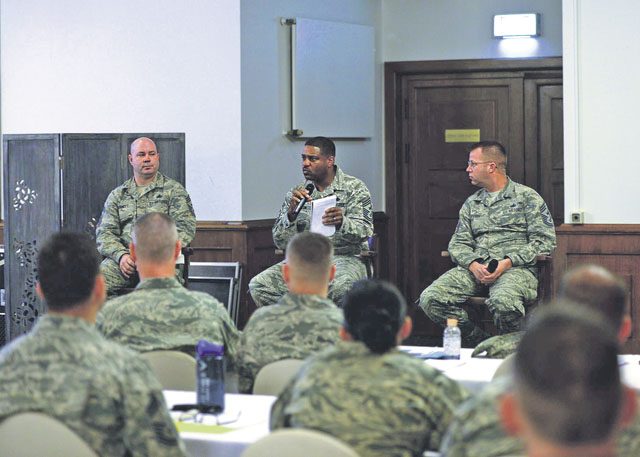
Chief master sergeants from around U.S. Air Forces in Europe and Air Forces Africa met Nov. 2 and 3 at the Ramstein Officers’ Club.
The Chiefs’ Business Symposium was held to give senior enlisted advisors an opportunity to discuss hot topics and share concerns of the enlisted force among colleagues.
“With this event, we wanted to make sure all chiefs in our area of responsibility had an opportunity to discuss concerns or changes within the enlisted force,” said Chief Master Sgt. Roger Thorton, 603rd Air and Space Operations Center superintendent. “The other purpose was to give chiefs an opportunity to learn and develop themselves as leaders to maintain the standard of excellence the Air Force requires.”
During the two-day symposium, attendees discussed topics such as the Transition Assistance Program, enlisted professional military education, dealing with thought processes and biases and were able to partake in discussion with a command chief panel and a commander’s panel.
“The panels allowed us to get different perspectives on certain subjects, to include EPME and changes to the enlisted structure,” Thorton said. “We would bounce some of the same ideas off of both groups and get not entirely different answers but different perspectives of the topics. It allows us to see how others think.”
While the panels help put some topics into perspective, the key to chiefs’ development was the communication between peers in open discussions.
“While we were sharing ideas, we got to learn how other chiefs dealt with scenarios differently than how we may have done it and then compare results,” Thorton said. “By developing ourselves and honing on these perspectives, we can build a consistency on how we operate.”
After providing senior enlisted advisors a medium to connect and explore different opinions, the importance of the symposium could be summed up by the USAFE-AFAFRICA command chief.
“Developing the next generation of leadership is the most important responsibility we have as chiefs,” said Chief Master Sgt. Kaleth Wright, USAFE-AFAFRICA command chief. “The first step in doing that is continuing to (develop) ourselves.”


